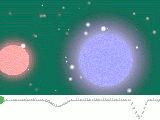Una estrella binaria eclipsante es una estrella binaria cuyo plano orbital cae tan cercano a la línea de visión del observador, que ambas estrellas se eclipsan mutuamente. Estas estrellas son parte variables no porque varíe la luz de sus estrellas individuales sino a causa de los eclipses. La curva de luz de una estrella de este tipo se caracteriza por períodos de luz prácticamente constantes, que disminuyen de intensidad periódicamente. Si una de las estrellas es más grande que la otra, ésta será oscurecida por un eclipse total, mientras la otra lo será por un eclipse anular.
El periodo orbital de las estrellas binarias variables eclipsantes puede determinarse a partir de un estudio de su curva de luz, y los tamaños relativos de las estrellas individuales con respecto al radio de su órbita, se pueden calcular observando lo rápido que cambia el brillo según se desliza el disco de la estrella más cercana por delante del de la más lejana. Si también es una estrella binaria espectral, los elementos de la órbita pueden ser determinados y como la masa de las estrellas puede calcularse de una forma relativamente fácil, también se pueden calcular sus densidades relativas.
Las estrellas binarias eclipsantes pueden clasificarse según la forma de su curva luminosa en tres tipos: EA Algol (Beta Persei), EB Beta Lyrae y EW Ursae Majoris
Los astrónomos aficionados también contribuyen con sus observaciones al descubrimiento de estos sistemas estelares. Aquí se presentan los datos correspondientes a una nueva estrella binaria eclipsante descubierta por Ramon Naves y Montse Campás del Observatorio Montcabrer MPC 213. La estrella es del tipo EW y tiene un periodo de aproximadamente 0,449 días.
 An eclipsing binary star is a binary star in which the orbit plane of the two stars lies so nearly in the line of sight of the observer that the components undergo mutual eclipses. Eclipsing binaries are variable stars, not because the light of the individual components vary but because of the eclipses. The light curve of an eclipsing binary is characterized by periods of practically constant light, with periodic drops in intensity. If one of the stars is larger than the other, one will be obscured by a total eclipse while the other will be obscured by an annular eclipse.
An eclipsing binary star is a binary star in which the orbit plane of the two stars lies so nearly in the line of sight of the observer that the components undergo mutual eclipses. Eclipsing binaries are variable stars, not because the light of the individual components vary but because of the eclipses. The light curve of an eclipsing binary is characterized by periods of practically constant light, with periodic drops in intensity. If one of the stars is larger than the other, one will be obscured by a total eclipse while the other will be obscured by an annular eclipse.The period of the orbit of an eclipsing binary may be determined from a study of the light curve, and the relative sizes of the individual stars can be determined in terms of the radius of the orbit by observing how quickly the brightness changes as the disc of the near star slides over the disc of the distant star. If it is also a spectroscopic binary the orbital elements chttp://www.blogger.com/img/blank.gifahttp://www.blogger.com/img/blank.gifn also be determined, and the mass of the stars can be determined relatively easily, which means that the relative densities of the stars can be determined in this case.
The eclipsing binary stars can be classified according to the shape of the light curve in three types: EA Algol (Beta Persei), EB Beta Lyrae and EW Ursae Majoris.
Amateur astronomers are also contributing with his/her observations to the discovery of these valuable systems. We can see the data from a new eclipsing variable star discovered by Ramon Naves and Montse Campás at the Montcabrer MPC 213 Observatory . It is a EW type eclipsing binary star with a period of approximately 0.449 days.
Más información en/More information at Portal Ciencia (español) /David's Astronomy Site (English)

No hay comentarios:
Publicar un comentario